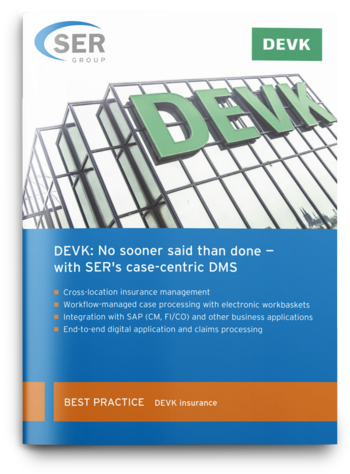SER Blog Innovation & Technology
From a system of record – to a system of understanding
Document management functionality in SAP is very basic, which is why an ECM solution has been a good add-on for some time. A state-of-the-art ECM system, however, is more than just a pure system of records. As a system of understanding, it automatically gleans valuable knowledge from documents and SAP data, enabling greater productivity, more efficient business processes, and improved compliance.

There are a lot of ECM systems on the market, but what are the most important criteria for an existing SAP customer with SAP Suite 7 or S/4 in combination with your ECM product Doxis?
Stefan Zeitzen: The emphasis, as you say, is on the “combination” of ECM and SAP. The document management functionality in SAP is very basic – and this makes an ECM system almost a necessity. It also brings added value, from compliance to usability.
An ECM system can provide conventional SAP users with an overview of their business processes. This not only includes process data from SAP but also documents that accompany an order, delivery or purchase order. These documents are not typically in SAP, rather are found in email inboxes, file directories, CRM systems, or even paper form.
Creating a single source of truth for all the necessary information, which also helps to automate processes and ensure they are audit-proof, is one important reason for SAP customers to choose an ECM system. Our customer statistics also demonstrate that the combination of SAP ERP and Doxis makes sense: more than 70 percent of SER Group's customers have integrated Doxis and SAP.
Does the implementation differ with regard to Suite 7 with AnyDB and S/4 based on the HANA platform?
Zeitzen: Yes, in principle. However, our ECM solution, for example, has its own infrastructure and is technologically independent from the SAP platform. So it doesn't matter which database is behind it. If we compare Business Suite 7 with S/4 and the SAP Cloud Platform, however, there are differences in implementation. With S/4 users get a state-of-the-art user interface with new technologies.
This calls for a new type of integration, which in our case is provided by the Doxis SmartBridge for SAP and, for example, provides a comprehensive attachment list for Fiori apps that is no longer available in Fiori. A further benefit is that solutions such as invoice processing work in both universes and can, in principle, be migrated as well. For companies that archive documents and data from SAP and are thus cleaning up their existing SAP systems, this can also help when switching from R/3 to S/4.
SER Group and SAP: What, in your opinion, are the SER Group's unique selling points?
Zeitzen: Our SAP expertise is a unique selling point. The SER Group has been a certified SAP partner for more than 30 years and, based on our extensive product knowledge and API expertise, we develop a wide range of solutions for end-to-end digital business processes that are used by medium-sized companies and corporations.
The certified Doxis connectors and add-ons for SAP provide intelligently automated processes throughout the company that streamline and accelerate work for both SAP and non-SAP users by providing a 360-degree view of the relevant business context.
Even departments without SAP access need to have an overview of business processes and related information, in the same way that SAP users need to access documents outside of SAP. Doxis bridges the gap between the two by linking the required information from SAP, CRM, emails, file systems, etc. and creating a 360-degree view of the process.
Does every existing SAP customer need an ECM system or are standard SAP tools enough?
Zeitzen: Document management is not a strength of SAP. However, business processes are comprised of more than data. Documents also play a major role, as every company knows. This shortcoming of SAP is nothing new. Yet in times of Covid-19 this issue has had a greater impact.
It can be a challenge to find the right SAP documents, not to mention documents outside SAP. An ECM system changes this in the blink of an eye and adds a lot of standard functionality that otherwise would have to be implemented in SAP at great expense. It would also, for example, stand in the way or have to be re-engineered when changing SAP technology. From our point of view, SAP or ECM are not in competition. In fact, these solutions complement each other.
Which is the lead system?
Zeitzen: It's not a question of which system leads – that depends on the specific use case. Sometimes SAP takes the lead, sometimes the ECM system. It's more important that users have a 360-degree view of information and are supported across business processes. One good example of this is our customer DEVK.
The insurance company uses SAP Claims Management for settlements and Doxis to archive the documents generated in this process. Whenever the focus is on documents, the ECM is the lead system. This solution enables DEVK to digitize and manage all incoming documents from mail and onward; it also distributes tasks across its offices and processes new requests and contracts.
This has reduced the time and expense for distributing mail by 75 percent, making it possible to respond to customer concerns on the same day. Such speed is unimaginable with SAP alone.

DEVK: Process-centric DMS
Learn how DEVK uses Doxis and SAP to streamline its processes, offer first-rate service and protect the personal data of policyholders.
Read nowWhere should you install an ECM? In the cloud or on premises?
Zeitzen: Both options have their advantages. We focus on our customers’ wishes and their IT strategy. On-premises ECM provides secure local use of data and the greatest possible personalization of the ECM system. When departments run their applications in the cloud, a cloud-based ECM solution makes more sense.
With SaaS, access is available anytime, anywhere. An elegant solution is a hybrid model, in which particularly sensitive information is stored locally on-premises and other information is available globally in the cloud. Doxis provides the flexibility for all of these options based on one software platform.
Are trends like AI and RPA having an impact on ECM development?
Zeitzen: When companies come to us, we explain to them that ECM is developing from a system of records to a system of understanding. In the past, the focus was mainly on storing information. However, modern ECM, such as our platform Doxis, is about intelligent information management: analyzing and utilizing the content of these documents to create added value. What we call the return on information.
With AI processes, we can gain insights from new documents and the document repositories. Based on this information, we can, for example, automate processes even further, substantially improve customer experience, identify risks and relieve users of routine tasks.
The cognitive services required for these activities are integrated deeply in Doxis, and we can also add other services from Microsoft, Amazon and Google, for example, to enhance solutions as required.
This interview was originally published in E-3 Magazin, issue 20-12
The latest digitization trends, laws and guidelines, and helpful tips straight to your inbox: Subscribe to our newsletter.
How can we help you?
+49 (0) 30 498582-0Your message has reached us!
We appreciate your interest and will get back to you shortly.




